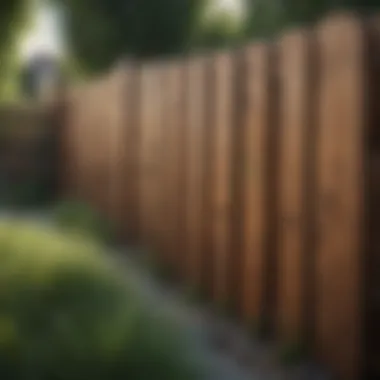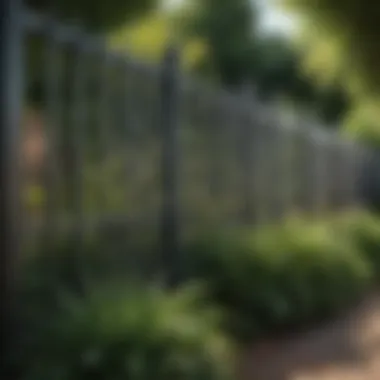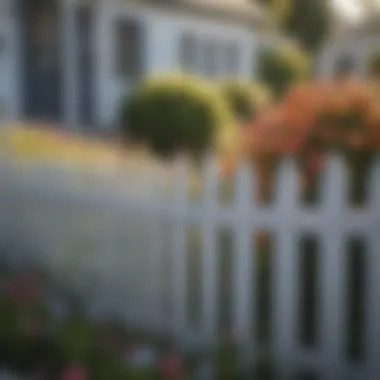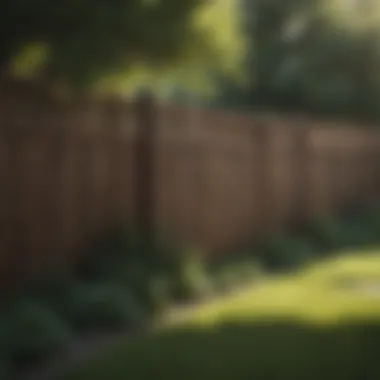Understanding Average Backyard Fence Costs


Intro
When considering the installation of a backyard fence, homeowners often face a labyrinth of choices. Each decision can greatly influence both aesthetic appeal and financial expenditure. The importance of understanding the average costs associated with different fence types remains paramount for effective budgeting. This article delves deep into the elements that shape the cost of backyard fences, providing clarity in a complex demand.
Factors Influencing Cost
Several key elements determine the overall expense of a backyard fence. Understanding these can help homeowners navigate the various financial considerations:
- Material Selection: The choice of material is perhaps the most significant factor affecting the cost. Options range from classic wood, durable vinyl, to robust metal varieties. Each material has its price point, durability, and maintenance requirements.
- Installation Expenses: Labor costs can vary widely depending on the complexity of the installation process. Professional installation may seem expensive, but can save time and ensure the job is done properly.
- Fence Height and Length: The size of the fence directly impacts its cost. Taller fences require more material and additional labor, while longer perimeters also escalate expenses.
- Local Regulations: Homeowners should also consider local building codes and zoning laws. These can dictate fence height and material, potentially affecting the overall cost.
Understanding Your Options
Assessing different types of fences is crucial in making an informed decision. Below are some common materials with costs:
- Wood Fences: Typically cost between $15 to $30 per linear foot, excluding installation.
- Vinyl Fences: Can range from $20 to $40 per linear foot.
- Chain Link Fences: Usually the most cost-efficient, priced around $10 to $20 per linear foot.
- Composite Fences: Generally more expensive, starting at $25 per linear foot, but require less maintenance than wood.
"Choosing the right fence is vital. It enhances privacy, defines boundaries, and adds value to a property."
Budget Planning
To effectively budget for a new fence, homeowners should account for:
- Material Costs: Include the price per linear foot multiplied by the total length.
- Installation Costs: Clarify whether installation is DIY or professional.
- Maintenance Over Time: Consider long-term maintenance costs associated with various materials.
By understanding the variables affecting the costs associated with backyard fencing, homeowners are better equipped to make sound financial choices. This knowledge allows for a seamless and successful project that aligns with their aesthetic desires and budgetary constraints.
Prelims to Backyard Fencing Costs
The subject of backyard fencing costs is a pivotal aspect of home improvement and property development. Understanding this topic equips homeowners with the necessary knowledge to make well-informed decisions. A fence not only defines boundaries but also enhances the aesthetics and security of the home. As such, recognizing the costs associated with different fencing options is crucial for effective planning.
Purpose of Backyard Fencing
Backyard fencing serves multiple purposes. Primarily, it establishes a clear boundary that defines property lines. This can prevent disputes with neighbors and provide privacy for outdoor activities. Furthermore, fences act as a security measure, keeping unwanted animals and trespassers at bay. In addition to these practical roles, fencing can also enhance the appeal of a property. Various designs and materials can complement the home's architecture, thereby increasing its curb appeal.
Importance of Budgeting
Establishing a budget for a backyard fence is essential. Costs can quickly escalate, influenced by material choices, dimensions, and labor requirements. By setting a financial framework, homeowners can prioritize essential features while avoiding unnecessary expenditures. A well-designed budget provides a roadmap for selecting materials and services that align with both the homeowner’s financial capabilities and design aspirations. Without a budget, it is easy to overlook costs that may arise post-installation, such as maintenance or repair, which are crucial for long-term planning.
"A clear understanding of fencing costs leads to better decision-making and satisfaction with the final result."
This article will delve deeper into the various components influencing fencing costs, facilitating a more enlightened investment in this important home feature.
Factors Influencing the Cost of a Backyard Fence
When considering the installation of a backyard fence, understanding the various costs associated is crucial for homeowners. The overall price of a fence is not just a simple figure; it is shaped by multiple elements that vary by situation and preference. This discussion focuses on the factors influencing the costs, which include the type of material, the height and length of the fence, geographical location, labor costs, and necessary permitting and regulations. Recognizing these influences assists in making informed decisions and helps set realistic budget expectations.
Type of Material
Wood
Wood fencing is popular among homeowners due to its natural appearance and versatility. The main characteristic of wood is its aesthetic appeal, making it a common choice for various landscape designs. This type of material is often customizable in design and can fit different styles, from rustic to modern. However, the disadvantages include potential vulnerability to weather, rot, and insects, which can lead to higher maintenance costs over time. Thus, while wood fences contribute charm and character, they require ongoing attention and expense.


Vinyl
Vinyl fencing has gained attention for its durability and low maintenance requirements. It offers a clean and uniform look which many homeowners find appealing. This material does not splinter, rot, or fade as easily as wood, providing a long-lasting solution. However, the initial cost can be higher than wood, which might deter some buyers. Vinyl's unique feature lies in its resistance to damage and the minimal upkeep needed, making it a practical choice for busy homeowners who prefer functionality over constant care.
Metal
Metal fences, such as aluminum or wrought iron, are known for their strength and longevity. They add a sense of security and can enhance the visual appeal of a property. Key characteristics include resilience against weather elements and minimal maintenance. Some homeowners appreciate the elegant designs that metal fences offer, contributing to property value. However, the downside can be their higher initial cost compared to wood, and while they are lasting, they may not provide as much privacy unless designed with slats or panels.
Chain Link
Chain link fencing is favored for its affordability and practical utility. The main feature is its ability to mark property lines while maintaining visibility, which is crucial for security without obstructing views. This type is particularly appealing for those who need a basic barrier without high costs. However, chain link lacks the aesthetics that some homeowners desire and may not offer sufficient privacy. Therefore, while it serves an essential function, the decision to choose this option often depends on budget constraints and the intended purpose of the fence.
Height and Length of the Fence
Height and length are pivotal in influencing the overall cost of the fence. Taller and longer fences will naturally incur higher expenses due to increased material needs and labor intensity. Additionally, many areas have specific regulations regarding maximum height and necessary permits, which can further complicate costs. Therefore, before deciding on a height and length, it's essential for homeowners to assess their needs and check local building codes to avoid unexpected expenses.
Geographical Location
Geographical location plays a significant role in fencing costs. Prices can vary widely by region due to local labor rates, material availability, and climate considerations. For example, areas prone to severe weather may require more robust materials, increasing the overall budget. Additionally, supply chain issues in certain regions can lead to higher costs for materials. Homeowners must consider these factors when calculating their total budget for a backyard fence.
Labor Costs
Labor costs can be a considerable part of the total expense of installing a backyard fence. Rates will vary depending on the company's reputation, geographical area, and the complexity of the installation. It's advisable for homeowners to obtain several quotes before making a decision. Employing skilled labor may seem pricier upfront but can ensure quality installation, potentially saving money on future repairs.
Permitting and Regulations
Lastly, understanding local permitting and regulations is crucial in determining fencing costs. Many regions require homeowners to obtain permits before constructing a fence, leading to additional fees. Furthermore, each locality has its own set of regulations that dictate the height, style, and materials used. Familiarizing oneself with these rules can help avoid unexpected expenses and ensure that the fence meets all legal standards.
The cost of a backyard fence is rarely fixed; it varies based on material, height, location, labor, and regulations.
Navigating these factors thoughtfully will allow homeowners to articulate a clearer understanding of the total costs involved in fencing decisions.
Average Cost Breakdown by Material
Understanding the average cost breakdown by material is crucial for homeowners planning to install a backyard fence. Each material comes with its own cost implications, advantages, and considerations. Knowing these details helps in making an informed decision that not only fits your aesthetic vision but also aligns with your financial capacity. Let's explore different materials to give a clear perspective on their costs.
Wood Fences
Cost per Foot
When looking at wood fences, the cost per foot typically ranges from $15 to $30. The price depends on the type of wood used, such as pine, cedar, or redwood. Cedar is often preferred due to its natural resistance to decay. One key characteristic of wood fences is their aesthetic appeal. They can be easily customized to fit various styles. However, while the initial investment might be less compared to some materials, the longevity can vary greatly. Wood requires maintenance to manage fading, warping, and insect damage.
Maintenance Considerations
Maintenance considerations are critical when choosing a wood fence. Regular staining or painting can prolong the life of the material, but this adds to the overall cost. Many homeowners appreciate the natural look that wood provides. However, neglecting maintenance can lead to expensive repairs or the need for a complete replacement in just a few years. Thus, understanding the maintenance routine is essential to budgeting effectively.
Vinyl Fences
Cost per Foot
Vinyl fences usually cost between $20 and $40 per foot. They are often viewed as a more modern alternative to wood. One notable characteristic of vinyl is its durability. Unlike wood, it does not require frequent painting or staining. The unique feature of vinyl fences is their range of styles and colors. They can last much longer than wood with minimal upkeep. This initial investment is generally higher, but lower maintenance costs can balance the equation over time.
Long-term Benefits


The long-term benefits of vinyl fencing include its ability to withstand harsh weather without fading, warping, or cracking. Homeowners value this because it means less time spent on repairs and more time enjoying their yard. One advantage is also its resistance to pests, which is a concern with wood. While vinyl may have a higher upfront cost, the lower maintenance and potential longevity make it a wise choice for those seeking less hassle down the line.
Metal Fences
Cost per Foot
Metal fences, such as wrought iron or aluminum, range from $30 to $100 per foot. The key characteristic here is their robust strength. Metal fencing can offer enhanced security features that many homeowners find appealing. Although the cost is higher than wood, the durability often justifies the investment. The unique feature of metal fences is their ability to withstand extreme weather without bowing or rotting. However, buyers must consider the potential for rust, depending on the metal type and finish.
Durability and Aesthetic Value
When it comes to durability and aesthetic value, metal fences stand out. They serve dual purposes of security while adding a classic look to the property. This type of fencing often requires minimal maintenance. Homeowners appreciate the longevity that comes with quality metal materials. Still, installation can be complex, which could increase overall costs. Understanding both durability and aesthetic aspects will assist in deciding if a metal fence meets your expectations.
Chain Link Fences
Cost per Foot
Chain link fences are generally the most economical option, costing between $10 and $20 per foot. One notable characteristic of chain link is its transparency, providing a clear view without obstructing the scenery. This makes it an attractive choice for homeowners who want to delineate their property while keeping their yard visible. The low-cost aspect makes it very appealing, but it's important to assess whether it meets your security needs.
Functionality and Security
Functionality and security are crucial when evaluating the value of a chain link fence. It is practical for large areas or installations requiring a low fence barrier. Chain link can be reinforced with barbed wire or slats for added security and privacy. However, compared to other materials, it may lack the visual appeal that some homeowners desire. Evaluating its functionality relative to other fencing options is imperative for making a complete assessment.
"Choosing the right material for a backyard fence goes beyond just price; it's about understanding the value and long-term implications of your investment."
Costs Associated with Installation
When considering a backyard fence, understanding the costs associated with installation is crucial. This aspect greatly influences the overall budget and can determine the type and quality of fencing you can afford. The decision between DIY or hiring a professional can have profound financial implications. Additionally, labor costs, tools, and equipment needed all contribute to the final tally.
DIY vs. Professional Installation
Choosing between DIY and professional installation involves more than just personal preference. Many homeowners wish to save money and decide to take on the task themselves. However, this can sometimes lead to unexpected challenges.
- Skill Level: Not all homeowners possess the necessary skills to install a fence correctly. Poor installation can lead to problems down the line, including leaning, instability, or even legal issues with neighbors.
- Time Investment: A DIY project can take considerable time, especially if you are not experienced. You need to account for planning, preparation, and physical work.
- Cost Comparison: While hiring a contractor may seem costly upfront, they can ensure high-quality workmanship and save you potential repair costs. It's important to carefully weigh the pros and cons of both options.
Average Labor Costs
Labor costs for fence installation can vary greatly based on several factors, such as location and type of fence being installed. Understanding these costs is important when planning your budget. Here are some typical considerations:
- Hourly Rate: Professional fence installers usually charge an hourly rate, which can range from $30 to $80, depending on their experience and the region.
- Complexity of Installation: If the installation involves complicated terrain or requires advanced skills, costs will increase. This can lead to additional charges for specialized labor.
- Permits and Regulations: In some regions, you may need to obtain permits before installation. This process often incurs additional fees, contributing to overall labor costs.
Tools and Equipment Required
If you opt for a DIY installation, it is essential to have the right tools and equipment on hand. This can be a significant factor in determining whether the DIY route saves money or ends up costing more.
Here is a list of common tools and equipment needed for installing a fence:
- Post Hole Digger: For digging holes for the fence posts.
- Level: Ensures that the fence is straight and even.
- Tape Measure: Necessary for accurate measurements.
- Power Drill: Useful for securing fences.
- Saws: Depending on fencing material, you may need a circular saw or a handsaw.
- Safety Gear: Glasses, gloves, and ear protection are crucial for safety.
Acquiring these tools may involve upfront costs and potential rental fees if you do not own them already. Some people may find this worthwhile, while others may lean towards hiring professionals to save time and hassle.
Understanding these elements helps homeowners make informed decisions about their fencing projects, impacting their overall satisfaction and financial planning.
Hidden Costs of Fencing


When planning for a backyard fence, it is crucial to understand that the upfront cost is not the only financial consideration. Hidden costs can significantly impact your overall budget and should not be overlooked. These costs might not be immediately apparent but play an essential role in your long-term expenses. Ignoring these elements can lead to an unpleasant surprise when the bill comes due after installation. Addressing these hidden costs ensures that homeowners are fully prepared for the financial obligations that accompany their investment in a fence.
Maintenance Costs
All types of fences require regular maintenance. Whether you have a wood, vinyl, or chain link fence, every material has its own maintenance needs and schedule. Wood fences often need staining or sealing to protect against weather damage. Vinyl and metal fences might require occasional cleaning to prevent mildew or rust.
Factor in these ongoing expenses as part of your budgeting. Regular maintenance not only preserves the appearance of your fence but also extends its lifespan, ultimately saving you money in the long run.
Repairing Damages
Damage is a risk with any fencing. Storms, pests, or even accidents can lead to unexpected repairs. Costs related to these repairs can vary based on the severity of the damage and the material of the fence. For example, a bent metal fence might be repaired simply by straightening it, whereas a wooden fence could require panel replacement.
Knowing how much to budget for potential repairs is important. Building a separate fund for these repairs can alleviate financial pressure when emergencies arise.
Insurance Implications
Insurance is another hidden cost that many homeowners overlook when installing a fence. Fences may affect your homeowners insurance premiums. Check your policy to ensure your new fence is covered against possible damages. Additionally, some insurance policies might require that you disclose the type of materials used.
To protect your investment and avoid gaps in coverage, ensure that your insurance agent is aware of your fencing plans. This way, you can maintain peace of mind, knowing that you will not face unexpected costs should your fence sustain damage.
Remember, understanding and planning for hidden costs is as important as knowing the initial investment required for a backyard fence. No homeowner wants to deal with unexpected financial burdens after installation.
Cost Comparison by Region
When contemplating the installation of a backyard fence, geographical factors play a crucial role in determining the overall cost. This section examines how regional variations impact pricing and what homeowners should consider.
Different areas often experience unique economic conditions, local regulations, and labor market variances. For example, urban regions typically have higher labor costs due to increased demand for skilled laborers. In contrast, rural locations often feature lower installation expenses, allowing for more cost-effective fencing solutions. The choice of materials may also be influenced by regional availability.
Key Elements Affecting Costs by Region
- Labor Costs: Regions with a higher cost of living tend to have elevated labor rates. In metropolitan areas, skilled tradespeople usually charge more for their work compared to those in less populated rural settings.
- Material Availability: The proximity to suppliers affects the price of fencing materials. Coastal areas might have better access to specific wood types, while urban centers may have various modern materials readily available.
- Regulations and Permits: Certain areas require specific permits and have regulations that could affect installation costs. Failing to navigate local laws can lead to unexpected expenses and delays.
- Seasonal Demand: Weather patterns can also dictate fencing costs. Spring and summer months typically see a rise in installation projects, driving prices up due to increased demand.
Benefits of Understanding Regional Cost Variances
By understanding how costs differ by region, homeowners can better plan their fencing budgets. Knowledge allows for more informed decisions, whether opting for a more affordable local material or engaging labor at a competitive rate during off-peak seasons. Homeowners also gain insights that help in negotiations with contractors, ensuring they receive fair pricing.
"Understanding regional differences in fencing costs can lead to significant savings and smarter investments in home improvement."
Final Considerations
Homeowners should research and gather quotes from multiple contractors within their specific regions to grasp a clearer picture of expenses. Engaging local landscaping forums or community pages can provide invaluable information on trends and average costs specific to particular areas. A well-informed approach to understanding regional costs will greatly contribute to the success of your backyard fencing project.
Ending
Understanding the costs associated with installing a backyard fence is crucial for homeowners seeking to enhance their property. A well-informed decision can lead to not only aesthetic improvements but also to financial savings. By summarizing key points covered in this article, we provide a clear perspective on various factors impacting fencing costs.
Summarizing the Costs
Throughout this discussion, we examined the average costs of different fence materials such as wood, vinyl, metal, and chain link. Each material holds distinctive benefits and drawbacks, influencing both initial and long-term expenses. For instance, while wood fences may offer a classic look, they often require more maintenance than vinyl or metal options, which can affect overall pricing.
Labor costs also present a significant factor. Homeowners must consider whether to tackle the installation independently or hire professionals, as each choice carries varying price implications. Furthermore, regional differences in material availability and labor rates can cause prices to fluctuate greatly.
Final Considerations for Homeowners
When planning to install a backyard fence, homeowners should account for not only the upfront costs but also hidden expenses related to maintenance and repairs. Consider potential permitting requirements as well, as this can add to the initial budget.
Before making a final decision, it’s beneficial to outline your specific needs and preferences. Explore various options within budget constraints. Gathering detailed quotes from multiple suppliers or contractors can also offer clarity on what to expect.
Ultimately, a thorough understanding of costs and considerations ensures that homeowners make informed choices, aligning their aspirations with practical financial planning.



